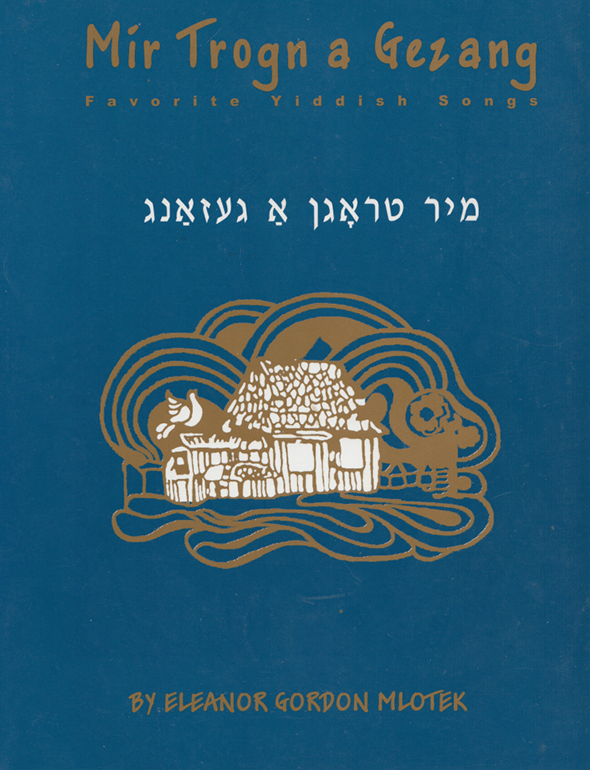To our knowledge this popular folk song was first published in the United States in 1940 by A. Bitter. The questions about the stone, heart and love are the most popular ones. In one version (published in Mir Zingen in 1948) the Tum-balalayke song asks these questions as well as those of the old riddle song, which is an international ballad theme: What is higher than a house (a chimney), what is swifter than a mouse? (a cat), what is deeper than a spring? (the mind), what is more bitter than gall? (death), etc. The melody is similar to the folk song, “Gantse teg zits ikh aleyn.”
In the Kaunas ghetto, the police became the target of the song. “Tumbala, tumbala, play ghetto Jew, play a song about the Jewish bellowers.”

There’s a young man who is pondering
pondering and pondering, all night long
whom to marry, and not be ashamed,
whom to marry, and not be ashamed.
Tum-bala, tum-bala, tum-balalaika,
Tum-bala, tum-bala, tum-balalaika,
Tum-balalaika, play balalaika,
Tum-balalaika, let there be joy.
Girl, girl, I wish to ask you [these riddles]:
What can grow without rain?
What can burn without ceasing?
What can yearn, crying without tears?
Foolish lad, why do you need to ask?
A stone grows without rain;
love can burn without ceasing,
a heart can yearn, crying without tears.
Shteyt a bokher un er trakht,
Trakht un trakht a gantse nakht,
Vemen tsu nemen un nisht farshemen,
Vemen tsu nemen un nisht farshemen.
Refrain:
Tum-bala, tum-bala, tum-balalayke,
Tum-bala, tum-bala, tum-balalayke,
Tum-balalayke, shpil, balalayke,
Shpil, balalayke,
Freylekh zol zayn!
— Meydl, meydl, kh’vil bay dir fregn:
Vos ken vaksn, vaksn on regn?
Vos ken brenen un nisht oyfhern?
Vos ken benken, veynen on trern?
— Narisher bokher, vos darfstu fregn?
A shteyn ken vaksn, vaksn on regn;
Libe ken brenen un nisht oyfhern,
A harts ken benken, veynen on trern.
שטײט אַ בחור און ער טראַכט,
טראַכט און טראַכט אַ גאַנצע נאַכט:
װעמען צו נעמען און נישט פֿאַרשעמען,
װעמען צו נעמען און נישט פֿאַרשעמען.
רעפֿרײן:
טום-באַלאַ, טום-באַלאַ טום-באַלאַלײַקע,
טום-באַלא, טום-באלא טום-באַלאַלײַקע,
טום-באַלאַלײַקע, שפּיל באַלאַלײַקע,
שפּיל באַלאַלײַקע,
פֿרײלעך זאָל זײַן!
— מײדל, מײדל, כ׳װיל בײַ דיר פֿרעגן:
װאָס קען װאַקסן, װאַקסן אָן רעגן?
װאָס קען ברענען און נישט אױפֿהערן?
װאָס קען בענקען, װײנען אָן טרערן?
— נאַרישער בחור, װאָס דאַרפֿסטו פֿרעגן?
אַ שטײן קען װאַקסן, װאַקפֿן אָן רעגן;
ליבע קען ברענען און נישט אױפֿהערן,
אַ האַרץ קען בענקען, װײנען אָן טרערן.
Song Title: Tumbalalayke

First published in 1972, Mir Trogn A Gezang: Favorite Yiddish Songs was reprinted six more times (in 1977, 1982, 1985, 1987, 1988, 2000) due to popular demand. The songs in this anthology represent a sampling of beloved folk and well-known Yiddish songs, many of which are scattered in various song collections; some appear in very rare and inaccessible collections; and some were never before published. Folk songs comprise about a third of this volume and were selected mainly on the basis of popularity and sometimes for their historic significance. Needless to say, they are only representative of the vast, rich treasure of Yiddish folk material. The selection was made not only on the basis of personal preference, but in the knowledge they are favorites of many who sing these songs. Most of the songs represent the repertoire that was sung at Yiddish summer camps, May 1st demonstrations and at social gatherings. Many songs were introduced to American Jewry by Jewish immigrants who came to the United States after World War II, for whom these songs had been favorites in Poland and other East European communities destroyed by the Nazis.